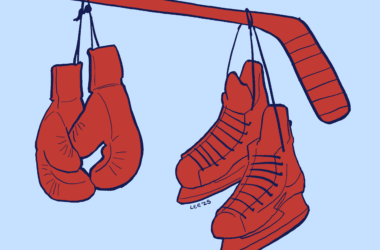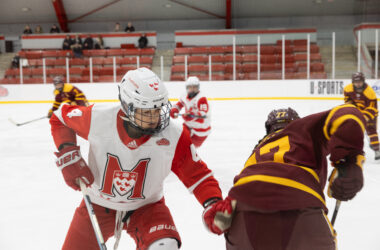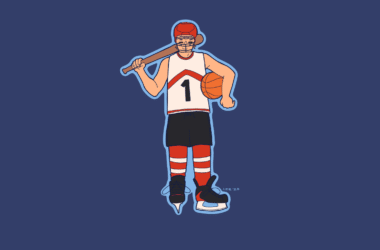Anti-fighting
Tillie Burlock, Managing Editor
Given the decline of fighting in hockey over the past decade, some may argue that there is no need to institute a formal ban. While it is enjoyable to watch the occasional bout between two tough guys, we must ask—at what cost? Fighting leads to an increased risk of chronic traumatic encephalopathy, a degenerative disease linked to repeated head trauma that can only be diagnosed after death. It wreaks havoc on the body, and many players who fought throughout their careers suffer from both physical ailments, mental health issues, and even premature death.
The most common claim made by those wanting to keep fighting in hockey is that it “polices” the game. The “unwritten” rules of hockey dictate that a dirty hit or play will result in the perpetrator having to fight. Therefore, many argue that the prospect of fighting acts as a deterrent against dangerous plays. However, a 2022 study contradicts claims that fighting deters further violence in games and goes on to emphasize the link between fighting and traumatic brain injury. After examining all penalties in the National Hockey League (NHL) for games between the 2010-11 and the 2018-19 seasons, the study found that of the 2,842 games in the period with a fight, there was a 66 per cent increase in violent minor penalties committed in ensuing game play, compared to games without a fight.
Moreover, the NHL’s inconsistency with enforcing rules on hits from the behind or to the head, combined with the increased pace at which today’s game is played, makes it near impossible to correctly decipher which plays warrant a fight. As such, players often end up being forced to fight for clean plays. The declining role of the enforcer––players whose main job is to fight and protect their teammates––means that oftentimes, skillful, smaller players who are not good fighters are forced to “answer the bell.”
If you can’t get on board with eradicating fighting from the NHL level, you should support banning it from the Canadian Hockey League (CHL)––Canada’s Major Junior League. The CHL currently faces a number of lawsuits from players who allege that teams pressured them to fight when they were as young as 16 among a range of other issues within the CHL such as hazing and sexual abuse. As teenagers, they would match-up against fully grown 20-year-old veterans and even years removed from playing, a number of them claim they still suffer the consequences.
Pro-fighting
Liliana Mason, Opinion Editor
Ryan Reaves said it best: “Make hockey violent again.” Fighting in hockey has a legacy as long and as storied as the game itself. In fact, the first-ever game of indoor ice hockey in Montreal in 1875 was followed by a fight—though it was between players and spectators, rather than among the players. The NHL introduced the first official fighting regulation in 1922, just five years after the league was created.
In 1967, the expansion of the NHL precipitated the beginning of the “goon era,” as new teams attempted to compensate for their lack of playing talent. By the 1980s, 100 per cent of NHL games had fights. Although the frequency and severity of fights in this period saw many “goons” suffering from long-term injuries, this era of fighting is definitively over, and for good reason.
Still, fighting remains an important, and significantly more regulated, component of hockey games. Regulations include suspensions, extra fines, and penalties for players who instigate a fight, leave the bench to join a fight, or remove their helmet before a fight. With increased safety, dropping the gloves now has many important functions beyond the classic “enforcer” role. Fighting continues to be a significant draw for fans, building rivalries between teams and bringing a certain irreplicable excitement to games.
Moreover, hockey is a fast-paced, intense game that inevitably stokes tensions between players. The kind of fighting we see in the NHL now is a significantly less dangerous and bloody alternative to players attempting to get cheap shots off at one another in order to blow off steam.
Rather than focusing on fighting—an inevitable, valuable, and highly controlled part of the game—hockey organizations should shift their attention to more pressing safety issues such as the implementation of mandatory neck guards. And let’s be honest, even those against fighting love a little rock ‘em, sock ‘em moment.







